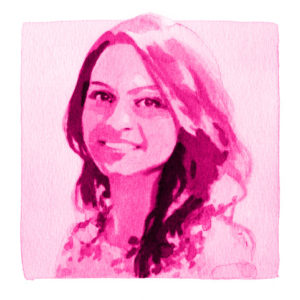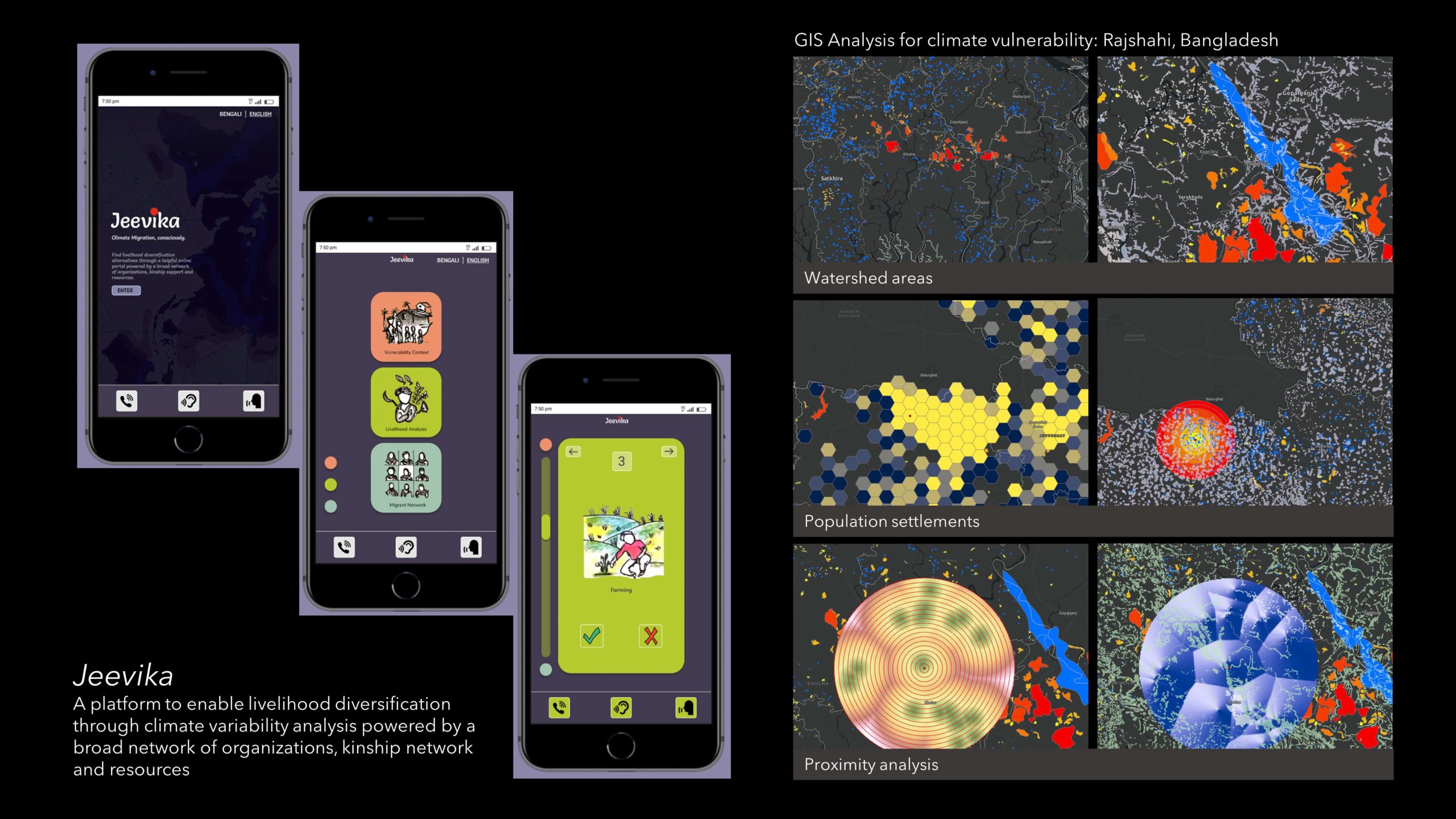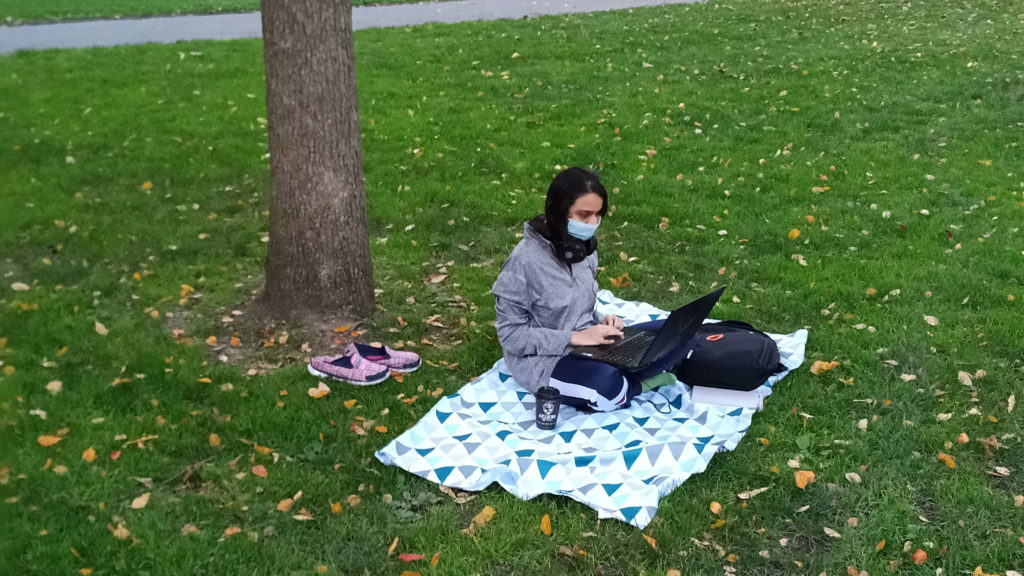
What is it like to be a Master in Design Engineering student at the Harvard Graduate School of Design and the Harvard John A. Paulson School of Engineering and Applied Sciences? In this series of candid conversations between students, Tomi Laja (MArch II ’22) speaks with Nupur Gurjar (MDE ’21) about her journey from an architect and set designer in India to Harvard student, taking courses at the Law, Kennedy, and Business Schools, and career paths in MDE.
What drew you to the GSD and the Master of Design Engineering program?
After finishing my architecture undergrad degree, I stepped into design roles that were a bit unconventional, but ones that enabled me to explore critical design thinking. The Master of Design Engineering program is about applying design thinking into various fields, not necessarily just for architecture or the built environment but for design in a broad sense. The approach applies systems of thinking across cultural experience, collaboration with teams, learning by doing. The students in my cohort are not all from a design background; in fact, their backgrounds range from engineering to economics. Here, design means problem-solving and using critical thinking, innovative ideas, and principles of design to apply the right kind of approach to a project.
Within MDE, I can bring in skills that are creative, critical, analytical, technical, and non-technical, and this gives me the freedom and flexibility to wear different hats and enter career paths as a designer who has the ability to understand problems and people.

I really like what you’re saying about this multi-dimensional view on both what design is, but also your role as a designer. What was your experience before entering the program?
I’m from Bangalore, India, and in my final year studying architecture, I decided to intern in Mumbai. That internship really gave me a deeper idea of my passion, likes, and dislikes. At that point, large-scale commercial architecture jobs stopped holding their appeal to me, so I started exploring.
I am also a performer and have been trained in classical dance and music. I entered the field of production design as a set designer for the media industry. I saw my training as a designer and a performer come together. Being a set designer was like looking at design and interiors through the lens of a camera that stretched beyond my drawings and 3D visualizations. I worked on a music video for Puma which was really colorful and cultural and for a web series with Amazon Prime. My second year of work experience was as a design research assistant in the city of Ahmedabad at CEPT University, Design Innovation and Craft Research Institute. I was part of a number of ethnographic field studies on vernacular furniture in northwest India. That opened doors to my interests in design research and engaging in a methodology to understand the influence of furniture design that has seamlessly integrated into the traditions, space, and life in communities.
You really took an opportunity to explore your path as a designer whether it was through architecture, set design, or research. Was a portfolio required for the MDE program?
Yes: Design Engineering accepts candidates from all different backgrounds, so the content of portfolios ranges. Some students have architecture projects, and others might emphasize research/ policy studies/ economics/ science and technology, etc. in their portfolio. The MDE program is very broad, and I tried to connect my diverse set of experiences and understanding of design to the vision of this program.
When submitting your portfolio, I would recommend that you show your process of learning, discovering, and thinking that led to certain decisions; include low-fidelity prototypes, sketches, and mock-ups for products/ services or experiences designed. This could depend on the kind of project being showcased, but ultimately, it is important to include why a certain intervention matters and what value or impact it has on society.
Within MDE, I can bring in skills that are creative, critical, analytical, technical, and non-technical, and this gives me the freedom and flexibility to wear different hats and enter career paths as a designer who has the ability to understand problems and people.
Was there a specific subject that you wanted to study when entering the GSD?
I looked forward to studying at the GSD, and to be frank, I did not have a specific focus at first. It was my first time traveling internationally, and I was looking forward to absorbing a new outlook on my student life experience. I remember my admiration while walking the halls of the GSD with professionals that I’d read about in publications. That was truly exciting for me. I wanted to immerse myself in experiences that would help me grow as a designer, within the conventional boundaries of where designers thrive but also beyond it, at the intersection of other emerging fields and technologies.
How is the MDE program structured, and what projects excited you?
The MDE program is semi-structured with some mandatory courses but also a considerable amount of flexibility. We have Design studios in our first year with exposure to a system of working in cross-functional teams on quick design sprints as well as longer projects on Product, Service, Experience design with a hint of Data visualization and UI/UX design based on project demands along different themes that is set for every MDE incoming cohort.
The first year can be exhausting, but it paves the way for our year-long Independent Design Engineering Project (IDEP) in the second year. I am working on designing an experiential service design intervention on climate migration in Bangladesh for vulnerable communities impacted by gradual climate events.
Have you taken any courses outside of the GSD?
Last semester I took “Conducting Negotiation on the Frontlines” at the Kennedy School of Government. It taught me about negotiation in a relational environment. It was an amazing course, and I think I was the only design school student. The experiential course design enabled the intersection of design thinking in humanitarian response. I met a lot of new people and made a lot of new friends.
Another course I cherished was at Harvard Law School, a place where I had never imagined design to be applicable. My interest in climate design led me into a project where we were looking at reducing artificial synthetic nitrogen fertilizers for farmers, and we were even able to visit Wisconsin for our research. I enjoyed the challenge of addressing a complex challenge for the farmers to enhance or maintain their yield while reducing the fertilizer application through a tool kit designed for fertilizer calculations and modeling.

That’s exciting. I’ve taken some courses outside of the GSD as well, focusing on Gender Studies and Curatorial Studies. I’ve been thinking of the Law School but find myself feeling intimidated: you’ve inspired me to go for it.
It is. It’s just amazing. Again, you meet a whole new bunch of people that you would not typically meet.
Do you have any specific advice for international students about life on campus and careers after MDE?
In terms of campus life, Harvard has endless opportunities, including incredible research and innovation labs. And relationships with the amazing faculty are invaluable. Living abroad can be expensive, but there are some great research and work opportunities on-campus for employment as an international student. As for career paths after MDE, there is no single answer—it depends on your background, project experiences, or even entirely new skill sets that are learned here which may lead to a whole new career pathway. MDE students have typically taken up jobs as product designers, UI/UX designers, system engineers, consultants, strategists, or even started their own venture post-graduation. Our path will be less about the job title and more about what we can bring in terms of design and problem-solving.
I’d love to hear about organizations you’ve been involved with at Harvard.
Firstly, I would like to tell any future student to balance your school time with your passions and interests beyond the classroom. Events happen on a daily basis in the form of conferences, lectures, social networking, and more. It can be overwhelming, but it is important to keep reminding yourself to prioritize and think of the value you seek during your time here.
In March 2020, I participated in the Harvard Circular Economy Symposium with students from the GSD, the Business School, and the Kennedy School; we organized the inaugural conference and worked on building an exposure and awareness of what “circular economy” means as a concept. I am still actively a part of that group. I also was a Community Service Fellow at the GSD last summer (2020). It is a fellowship for students at the GSD to work on a project with a nonprofit or a public organization in the US or abroad. I worked with Boston organizations on designing a Green Innovation district strategy to strengthen climate resiliency.
For the term 2020-21, I was elected as the Student Groups chair at the Student Forum GSD. I’m the liaison for the approximately 40 student groups at the GSD. We also have meetings with the dean and learn about the administrative side of the school. Being on the leadership side has always been very enriching for me.
I am also involved with the GSD Alumni Council’s Design Impact event series. I curated and moderated a panel in the Design Impact for South Asia event in February 2021 on climate migration, and I am using this opportunity to broaden my own passion and interest for climate migration in line with my thesis. I was also involved with the India Conference at Harvard, 2021 which led to some valuable connections to meet professionals working in this area. It is the largest student-led conference in the US, and is organized by students of the Business School and Kennedy School every year.
Finding ways to engage in programs outside of my coursework that complement my scholarship has been a real highlight of my time in the MDE program, and something I would recommend to any incoming student.
“Students in Dialogue” is a series of candid conversations between students at the Harvard Graduate School of Design. Interviewer Tomi Laja is currently a Master in Architecture II degree candidate at the GSD and Editorial Assistant with Harvard Design Magazine. Her interests include research-based architectural design, exhibition, and writing. Her independent research includes afro-futurist and eco-feminist perspectives as they relate to agency, consciousness, and the built environment.